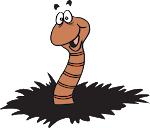Different Worm Species: Why do I recommend red wigglers for indoor composting?
I get this question pretty regularly, or one of the related questions:
- Can I mix different worm species?
- Can I use wild caught worms from my yard or compost pile?
The best way to begin this is to consider the conditions various worm species require to thrive.
The earthworm species most often used for composting are red wigglers (Eisenia foetida or Eisenia andrei).
Red wigglers are ideally suited to the indoor compost bin: they prefer
soil temperatures that are in the same range as the air temperatures where we are comfortable (65-75F), tolerate mixing and
lots of food in their environment, reproduce rapidly, and consume a lot
of food relative to their size. Eisenia worms can be found in old manure piles, but are not commonly found in yards in the northern US. Personally, I would not want to pick a pound of red wigglers out of a manure pile (and hope that I didn't grab any other critters) to start an indoor bin, but it could be done.
Although common nightcrawlers (Lumbricus terrestris) and field worms (Diplocardia or Octolasion)
may be easily found in your yard, they are not recommended for indoor
worm bin operations. These worms burrow deeper than most bins allow and
generally require cooler temperatures than typical for the indoor
environment. Also, because they build burrows, they do not tolerate
mixing (surface feeding is recommended) and may require dietary
supplementation of corn meal or other foods to thrive. Indoor vermicomposting with nightcrawlers is a method that others use with success. If
you're interested in trying night crawlers, I can refer you to experts
who can help you on your way.
Because
different worm species have different requirements, I do not suggest
mixing worm species in your worm bin. If conditions become unsuitable
for one species, they may die or leave your bin.
In general, I recommend
red wigglers for people interested in vermicomposting indoors. You really can't go wrong with a simple bin and a pound of bed run red wigglers.
Cheers,
Mark


No comments:
Post a Comment